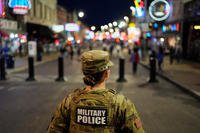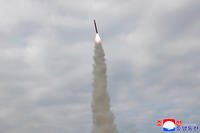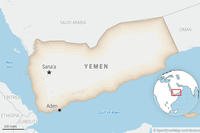COVID-19 vaccination disparities are emerging across race, ethnicity, education and age among U.S. troops, according to a new review by Defense Department health officials.
Black service members had the lowest vaccination rates of all races, at 18.7%, while personnel identified as Asian or Pacific Islander had the highest, at 32.8%. Roughly 29% of all White troops and 25.7% of Hispanic service members had been vaccinated, according to the study.
The report, published last week in the Defense Health Agency's Military Surveillance Monthly Report, was designed to assess overall vaccine initiation and completion in the early months of vaccine availability within the Defense Department, according to the authors.
Read Next: Free Health Care for All Troops Is Key Priority, National Guard General Tells Congress
The information, they wrote, could help "military leadership and vaccine planners" to be "knowledgeable about and aware of the disparities in vaccine series initiation."
"Significant disparities in vaccination by race, sex, and other factors exist in military populations," wrote the authors, all members of the U.S. military with medical degrees or doctorates in public health. "The U.S. military must continue to assess and address factors associated with COVID-19 vaccine hesitancy, including disparities, to ensure maximum force health protection against the virus."
According to the report, Black troops, women and those younger than age 24 were less likely than the average to have started a COVID-19 vaccination series. Other underrepresented groups in the vaccinated population included those of the lower enlisted ranks and those lacking a post-secondary degree.
The demographic disparities were similar across a subgroup of those vaccinated, military health care workers and those who had been fully vaccinated -- an indication that, given that the results mirrored that in the U.S. population, shows vaccine hesitancy exists among racial, ethnic and gender lines, the authors noted.
The researchers did not study those who had received the Johnson & Johnson vaccine as only a small number had been administered at the end of the study period.
Among the branches, the Army's initial vaccine rate was nearly 22%; the Navy's, 35%; the Marine Corps', 27.2%; and the Air Force's, 26.6%.
For the study, the researchers reviewed the medical data of all active-duty service members from December 2020 through March 2021. During the three-month period, 361,538 service members, or 27.2% of the active duty, received at least one COVID-19 vaccine dose.
Across occupational specialties, health care workers had the highest vaccination rates, at nearly 55%. This is unsurprising, as they were offered the vaccine first in the Defense Department's rollout. Pilots and aircrew were next, at 45.6%, followed by communications and intelligence personnel, at 25.4%.
Roughly a quarter of those in combat specialties, engineering and maintenance fields had received a vaccine, while motor transport personnel had the lowest initiation rates at 17%.
Rates were also lower among service members who had previously had COVID-19. According to the report, troops with a previous coronavirus infection were 20% less likely to have received a vaccine.
The researchers also found that, of the service members who were vaccinated before Jan. 29, roughly 94% received their required second dose within six weeks afterward.
The researchers said their findings of vaccine reluctance among racial and ethnic groups, both within the active-duty population and specifically in the military health care population, "mirror [what] has been observed within the U.S. population."
"This suggests that forces external to the U.S. military, such as interpersonal and societal factors, also contribute toward vaccine hesitancy," they wrote. "Messaging and other outreach efforts should aim to reduce or eliminate vaccine hesitancy in general, with attention focused on reducing vaccine disparities."
The authors noted that, since vaccine hesitancy tends to wane over time, the associations revealed by the research may also be reduced.
They added that they did not assess vaccine refusal since the DoD did not have the data on it.
As of Friday, 56% of active-duty service members have been vaccinated against COVID-19, according to Dr. Terry Adirim, acting assistant secretary of defense for health affairs. The DoD has administered 3.3 million vaccines to personnel and beneficiaries, including troops, eligible family members and retirees.
The DoD has tracked nearly 300,000 cases of COVID-19 among service members, civilian employees, contractors and dependents, including 350 deaths -- mainly among civilian employees and contractors, who tend to be older and therefore at higher risk for more severe cases of COVID.
Twenty-six service members and 12 family members have died.
-- Patricia Kime can be reached at Patricia.Kime@Monster.com. Follow her on Twitter @patriciakime.
Related: Half of Military COVID-19 Cases Hit These 4 Job Fields, New Report Finds















